Indoor Herb Gardens for Beginners: Grow Your Own Fresh Flavors
2/6/202512 min read
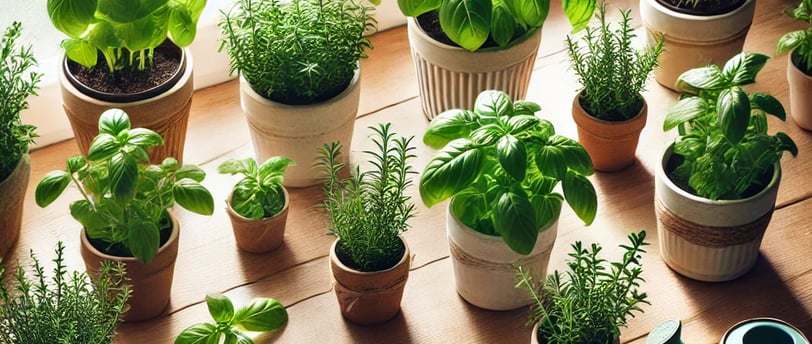

Growing herbs indoors can be both a delightful hobby and a practical way to ensure you always have fresh ingredients at your fingertips. From classic culinary staples like basil and oregano to aromatic favorites like rosemary and thyme, an indoor herb garden allows you to infuse your dishes with vibrant flavors directly harvested from your own windowsill or countertop. If you’ve ever dreamed of plucking a few sprigs of fresh mint for your morning tea or adding a dash of parsley to your evening pasta sauce, this beginner-friendly guide will help you cultivate your very own indoor herb haven. In this post, we’ll dive deep into everything you need to know—from choosing the right herbs and containers, to proper lighting, watering, harvesting, and much more. By the end, you’ll be ready to start growing a variety of herbs that will not only brighten up your kitchen but also elevate every meal.
1. Why Grow Herbs Indoors?
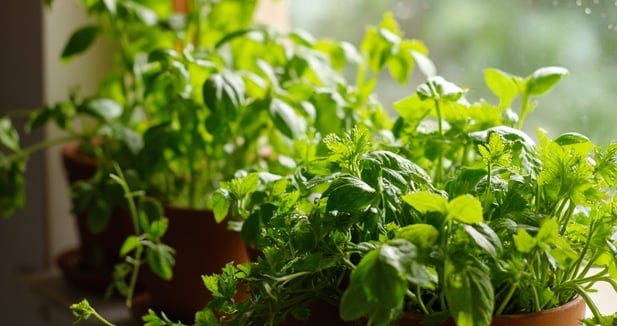

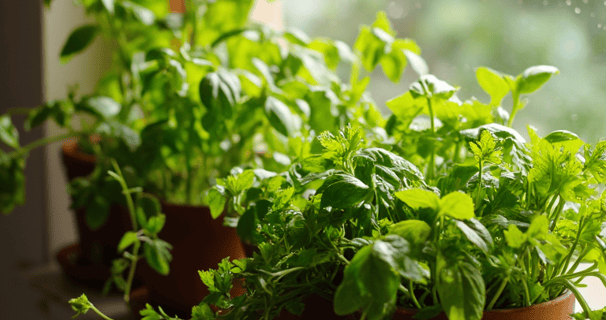

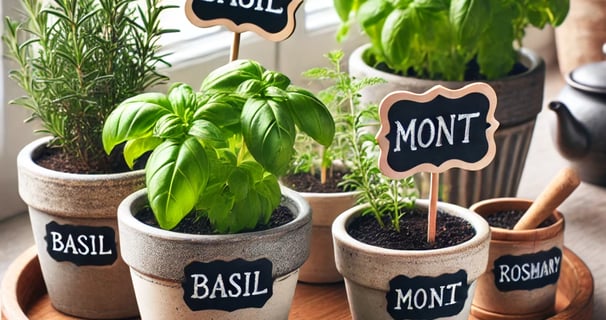

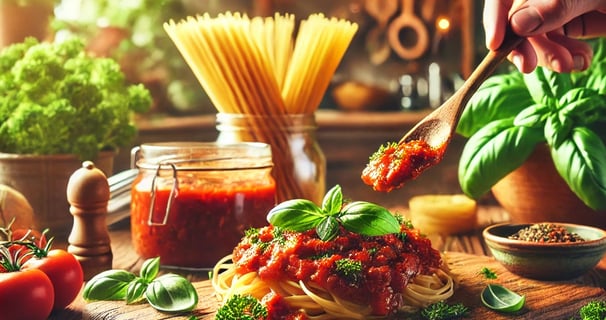

Convenience in the Kitchen
One of the most obvious perks of growing herbs indoors is the incredible convenience it offers. Imagine reaching over to your windowsill to snip a handful of fresh basil leaves, right as you’re preparing homemade pesto. There’s no need to run to the grocery store or wonder whether your market-bought herbs are still fresh. Indoor herb gardening places these vibrant plants within arm’s reach, allowing you to enjoy a constant supply of flavorful ingredients.
Year-Round Gardening
Outdoor gardens often face seasonal limitations—once winter arrives, many of your plants will wither, and you might find yourself pining for the tastes and aromas of summer. Indoor herb gardens, however, can thrive throughout all four seasons. By providing your herbs with the right conditions—consistent indoor temperatures, sufficient light, and proper watering schedules—you can maintain lush foliage all year long.
Aesthetic and Aromatic Appeal
Beyond their culinary benefits, herbs can also bring beauty and pleasant aromas into your home. Lush green leaves add a pop of color to your living space, while the distinctive scents of rosemary, mint, or lavender can instantly uplift the ambiance. Even if your indoor garden consists of a few small pots, the presence of vibrant foliage can bring a touch of nature to an otherwise sterile kitchen or living area.
Beginner-Friendly
Many herbs are surprisingly easy to grow, especially when compared to more temperamental houseplants. As long as you meet their basic needs—light, water, good soil—herbs will reward you with continuous growth. This makes them an excellent starting point for anyone new to gardening. If you’re worried about a lack of experience or a less-than-green thumb, don’t be! Herbs are often forgiving, and minor mistakes can be corrected without jeopardizing the health of your plants.
2. Choosing the Right Herbs
Consider Your Culinary Preferences
When deciding which herbs to grow, the most obvious factor should be which flavors you love to cook with. Do you frequently make Italian dishes? Basil, oregano, and parsley might be your best bet. Are you a tea lover? Mint and lemon balm could be perfect additions. Interested in experimenting with new flavors? Try unusual varieties like Thai basil or lemon thyme. Tailoring your herb selection to your taste ensures you’ll genuinely use what you grow.
Hardy Varieties for Beginners
Not all herbs have the same growing requirements. Some varieties are more forgiving of over- or under-watering and can adapt more easily to indoor conditions. If you’re brand new to gardening, consider starting with one or more of the following beginner-friendly herbs:
Basil: Loves sunlight and regular watering, grows quickly, and is very versatile in the kitchen.
Parsley: Tolerates lower light conditions, yet thrives with moderate watering and consistent temperatures.
Mint: Extremely robust; just be mindful that mint can grow rapidly and might overshadow other herbs if planted together.
Thyme: Prefers bright light and slightly drier soil; an excellent low-maintenance herb for various dishes.
Oregano: Does well with plenty of light and moderate watering; a staple in Mediterranean cooking.
Matching Herbs to Your Environment
Before you finalize your herb list, take a closer look at your indoor environment. Do you have a sunny windowsill with direct sunlight for several hours a day? Mediterranean herbs like rosemary, sage, and thyme will do well there. If your home is on the dimmer side, you might look into herbs that can handle partial shade, like chives or certain varieties of mint and parsley. Matching your herb choice to your home’s lighting conditions will greatly increase your chances of success.
3. Setting Up Your Indoor Herb Garden
Selecting the Ideal Containers
The type and size of container you choose can significantly impact your herb’s growth. Look for pots with adequate drainage holes at the bottom to prevent root rot. While decorative containers without holes might look appealing, they can trap excess moisture and suffocate the roots over time. You can work around this by placing your herb in a plastic nursery pot (with holes) and then setting that inside a more decorative container, as long as you remember to empty any collected water.
Container Materials:
Terracotta: Porous, allowing for better airflow and natural moisture wicking. Great for herbs that dislike sitting in water (rosemary, thyme).
Ceramic: Non-porous, which can help maintain moisture levels for herbs that prefer consistent watering (basil, parsley).
Plastic: Lightweight, affordable, and easy to handle; just ensure it has drainage holes.
Choosing the Right Soil
Not all potting mixes are created equal, and using regular garden soil might spell trouble indoors. Garden soil can be heavy, poorly draining, and possibly laden with pests or pathogens. For best results, go with a high-quality potting mix designed specifically for containers. If you want to optimize drainage further, consider adding materials like perlite or coarse sand. This is particularly beneficial if you’re growing Mediterranean herbs, which prefer drier conditions.
Lighting: Natural vs. Artificial
Herbs generally crave sunlight, often between four to six hours of direct light daily. A south-facing window is typically ideal if you live in the Northern Hemisphere. If your home lacks sufficient natural light, don’t fret—you can supplement (or replace) sunlight with grow lights. LED grow lights are energy-efficient, and full-spectrum versions mimic the sun’s natural light, promoting robust growth. Position these lights six to twelve inches above the plants and set them on a timer for around twelve to fourteen hours a day, depending on the herb’s needs.
Temperature and Humidity
Most herbs thrive in temperatures that match typical indoor comfort zones, ranging between 65°F and 75°F (18°C to 24°C). Extreme fluctuations—like keeping your herbs too close to drafty windows in winter or next to a scorching heater—can stress the plants. If your indoor air tends to be dry (especially during colder months), you might boost humidity by placing a tray of water near your plants or using a small humidifier. Herbs like basil, mint, and cilantro particularly appreciate moderate humidity levels.
Watering Techniques
When watering your herbs, remember the golden rule: water thoroughly, but let the excess drain away. Overwatering is one of the most common pitfalls for new gardeners, leading to soggy soil and root rot. Herbs like basil or parsley enjoy slightly more moisture, so you’ll want to water them whenever the top inch of soil feels dry. Others, like rosemary and thyme, prefer drier conditions, so allow the soil to partially dry out before watering again. Always check the soil moisture with your finger to avoid guesswork.
4. Essential Care and Maintenance
Fertilization
Indoor herbs rely heavily on the nutrients in their potting mix, which can become depleted over time. To maintain healthy growth, apply a balanced, water-soluble fertilizer (like a 10-10-10 or 5-5-5 NPK ratio) at half the recommended strength every two to four weeks. Over-fertilizing can lead to an overabundance of foliage but dilute flavor, so it’s best to err on the side of caution. Organic options, such as fish emulsion or compost tea, can also provide gentle, nutrient-rich feeding without the risk of chemical burn.
Pruning and Pinching
Pruning your herbs is essential for both health and flavor. Periodically pinching off the top leaves—especially with basil—encourages the plant to grow bushier, producing more of the tender leaves you love to eat. It also prevents the plant from flowering too early, which can sometimes lead to bitter-tasting leaves (as is the case with basil). Keep an eye on the overall shape of your herbs and remove any yellowing or leggy stems to encourage robust, healthy growth.
Pest Management
Indoor environments can still harbor common garden pests like aphids, spider mites, or whiteflies. Regularly inspect the underside of leaves for tiny bugs or webbing. If you spot any issues, address them promptly:
Neem Oil: A natural pesticide that can be diluted and sprayed on leaves, effectively controlling many types of insects.
Insecticidal Soap: Targets soft-bodied insects like aphids. Apply according to the product’s directions, making sure to cover the plant thoroughly.
Manual Removal: For small infestations, you can remove pests by gently wiping them off leaves with a damp cloth.
Keeping your herbs clean and well-ventilated, and avoiding overwatering can go a long way toward preventing pest problems in the first place.
Monitoring Growth
Just like any living organism, herbs communicate their needs through growth patterns and physical changes. Yellowing leaves could indicate overwatering or nutrient deficiency, while leaves that curl or turn crispy might suggest too much direct heat or insufficient moisture. Make it a habit to inspect your herbs daily, noting changes in leaf color, soil moisture, and overall appearance. Early detection of problems gives you a better chance of correcting issues before they become severe.
5. Common Mistakes to Avoid
Overcrowding
It might be tempting to cram multiple herbs into a single container to save space, but overcrowding can stress plants by forcing them to compete for nutrients, water, and sunlight. Many herbs prefer having their own container, especially if they have different watering requirements. If you do plant multiple herbs in the same pot, make sure they share similar growing conditions (for example, rosemary and thyme both like drier soils).
Ignoring Lighting Requirements
A sunny windowsill is often enough for certain herbs, but the angle of the sun and the length of daylight changes throughout the year. If you notice that your herbs are “reaching” or becoming leggy—stretching out with long, thin stems—this is a sign they aren’t getting sufficient light. Consider rotating your pots every few days to ensure even sun exposure, or invest in a grow light if natural light is limited.
Inconsistent Watering
Consistency is key. Watering too frequently can drown roots, while letting your herbs dry out completely can stunt growth. Set a schedule or reminder to check soil moisture levels. Adjust as needed based on the specific herb type and your home’s humidity.
Neglecting Regular Pruning
Many new gardeners worry that pruning or pinching will harm their plants. In reality, it’s the opposite. Regular pruning not only keeps your herbs looking tidy but also promotes new, lush growth. Avoid letting your herbs flower too soon; once some herbs go to seed, the leaves often lose flavor or become bitter.
6. Harvesting and Storing Your Herbs
The Right Time to Harvest
For most herbs, the best time to harvest is in the early morning when their natural oils are most concentrated. Aim to pick leaves just before the plant starts flowering—this is typically when flavor and aroma are at their peak. For herbs like basil, you can harvest regularly by pinching off the top sets of leaves. This encourages the plant to grow more branching stems and, consequently, more leaves.
Proper Cutting Techniques
Use clean, sharp scissors or pruning shears to avoid damaging the plant. Cut above a leaf node (the point where leaves attach to the stem) to promote branching and prevent awkward stems that won’t regrow. Always leave enough foliage behind for the plant to continue photosynthesis—generally, you want to harvest no more than one-third of the plant at any one time.
Short-Term Storage
If you’re using your fresh herbs the same day, simply wash them gently and pat them dry before use. If you need to keep them for a few days, you can store them in the refrigerator:
Moisture Method: Wrap stems in a slightly damp paper towel and place them in a plastic bag.
Jar of Water: For herbs with sturdy stems (like parsley or cilantro), trim the ends and place the bunch upright in a glass of water, then loosely cover with a plastic bag.
Long-Term Preservation
Drying: Gather small bundles of herbs, tie them at the stem, and hang them upside down in a warm, dry, and well-ventilated area. Once dried, crumble the leaves and store them in airtight containers.
Freezing: Chop fresh herbs and freeze them in ice cube trays with a bit of water or olive oil, then transfer the cubes to a freezer-safe bag. This method preserves flavor well, making it easy to pop a cube into sauces or soups later on.
7. Cooking with Fresh Herbs
Elevating Everyday Dishes
Fresh herbs can transform an ordinary meal into something spectacular with minimal effort. Whether it’s a sprinkle of chives on your morning eggs or a handful of basil in your homemade pizza sauce, these small additions can dramatically enhance flavors and aromas.
Pairing Suggestions
Basil: Perfect for Italian dishes, tomato-based sauces, pesto, or even fruity desserts.
Thyme: Complements roasted vegetables, meats, and stews; also lovely in baked goods like herbed bread.
Rosemary: Robust flavor that pairs well with roasted potatoes, lamb, and hearty soups.
Mint: Great for Middle Eastern dishes, cooling beverages, and sweet treats like chocolate desserts.
Parsley: A universal garnish that adds a bright, fresh note to almost any savory dish.
Experiment and Explore
One of the joys of growing herbs is the freedom to experiment. Don’t be afraid to step outside your culinary comfort zone. Try adding a bit of lavender to homemade ice cream or infusing fresh rosemary into olive oil. The more you explore, the more you’ll appreciate how versatile and transformative fresh herbs can be in your cooking.
8. Troubleshooting Common Indoor Herb Issues
Even with the best care, you may encounter some bumps along the way. Here are a few common issues and tips to help you troubleshoot:
Yellowing Leaves
Possible Causes: Overwatering, nutrient deficiency, or lack of light.
Solutions: Check drainage and adjust watering schedule. Consider fertilizing if you haven’t in a while. Make sure your plant is receiving enough light.
Leggy Growth
Possible Causes: Insufficient light, plants reaching toward a distant light source.
Solutions: Rotate your pots or place them in a brighter spot. Add supplemental grow lights if necessary.
Slow Growth or Stunted Plants
Possible Causes: Poor soil nutrients, incorrect temperature, or limited lighting.
Solutions: Ensure you’re using quality potting mix, maintain a stable indoor temperature, and verify your lighting setup.
Wilting or Drooping Leaves
Possible Causes: Underwatering, overwatering, or extreme temperature swings.
Solutions: Check soil moisture; water only when the top inch is dry. Keep plants away from heaters or drafty windows.
9. Expanding Your Indoor Garden
Beyond Basic Culinary Herbs
Once you’ve mastered the basics with staples like basil, mint, and parsley, you might want to expand your indoor garden with more adventurous varieties:
Lemongrass: Great for Southeast Asian cooking; grows well in a pot with plenty of light.
Stevia: A natural sweetener that can be used in beverages and desserts.
Lavender: Provides a soothing aroma; use it in baked goods, teas, or homemade sachets.
Companion Planting Indoors
Companion planting is often talked about in the context of outdoor gardens, but certain principles can apply indoors, too. For example, grouping herbs with similar watering needs together in a larger planter can simplify your care routine. A mini “Mediterranean garden” featuring rosemary, thyme, and oregano can thrive as a group, as they prefer well-draining soil and modest water. Meanwhile, moisture-loving herbs like basil and parsley are better suited to containers where soil can be kept slightly damp.
Adding Edible Flowers
Edible flowers such as nasturtiums or pansies can grow indoors as well, bringing a pop of color alongside your herbs. These blossoms are not only beautiful but also can be used as garnishes in salads or desserts. Ensure that you choose edible varieties free of chemical pesticides and that you provide adequate light for them to bloom.
10. The Joy of Homegrown Flavor
Cultivating your own indoor herb garden is a journey of discovery, one that offers practical rewards and a deeper connection to the food you eat. There’s something magical about nurturing a tiny seedling and watching it flourish on your windowsill—knowing that in a matter of weeks, you’ll be tasting the fruits (or in this case, leaves) of your labor. It’s a gentle reminder of nature’s cycles, even within the confines of our modern homes.
Mindful and Sustainable Living
Growing herbs indoors aligns well with a more conscious and sustainable lifestyle. By nurturing plants at home, you reduce the need for plastic-wrapped grocery store herbs and cut down on food waste, since you can harvest only what you need. It also offers an engaging way to teach children (and curious adults) about plant growth, responsibility, and the importance of fresh, whole foods.
From Seed to Table
The act of sowing seeds, watering them diligently, and harvesting the resulting greenery can be incredibly satisfying. You may find that your cooking creativity flourishes as well—trying out new recipes, experimenting with different flavor combinations, and even exploring homemade herbal teas or infused oils. In essence, an indoor herb garden can spark a renewed appreciation for what nature provides.
11. Final Thoughts
Starting an indoor herb garden is an accessible and rewarding project for both beginners and seasoned gardeners alike. By selecting herbs suited to your taste and environment, providing them with proper light, and offering consistent but careful watering, you’ll soon be rewarded with a plentiful supply of fresh, aromatic leaves. Take the time to prune regularly, monitor for pests, and give your herbs the attention they need to stay healthy. Before long, you’ll be snipping vibrant sprigs to add to your favorite recipes, impressing family and friends with the unparalleled flavor and fragrance that only homegrown herbs can offer.
Whether you’re motivated by a desire to cook fresher meals, improve your home’s air quality, or simply add some living greenery to your décor, indoor herb gardening invites you to reconnect with nature—right in the heart of your kitchen. As you gain confidence and learn from small successes (and even occasional missteps), you might find yourself expanding your collection or experimenting with lesser-known varieties. No matter your goals, the journey itself is filled with learning, growth, and of course, delicious rewards.
Welcome to your new adventure in the world of homegrown flavors. Here at The Home Garden Decore, we can’t wait to see what you’ll create next. Happy planting—and bon appétit!
Inspiration
Explore ideas for your home and garden.
© 2025. All rights reserved.
